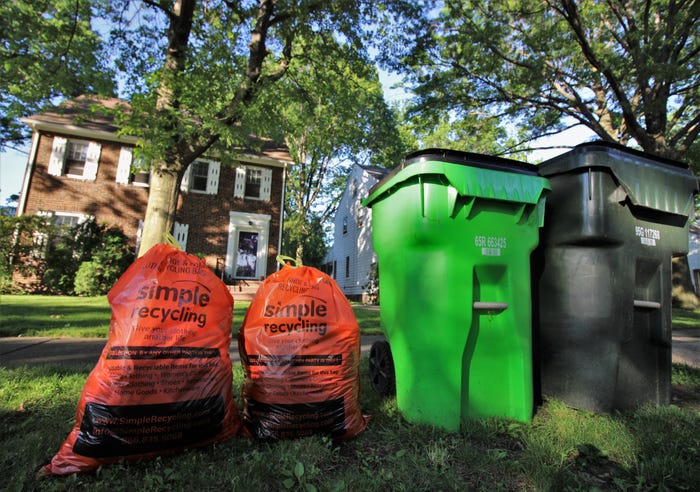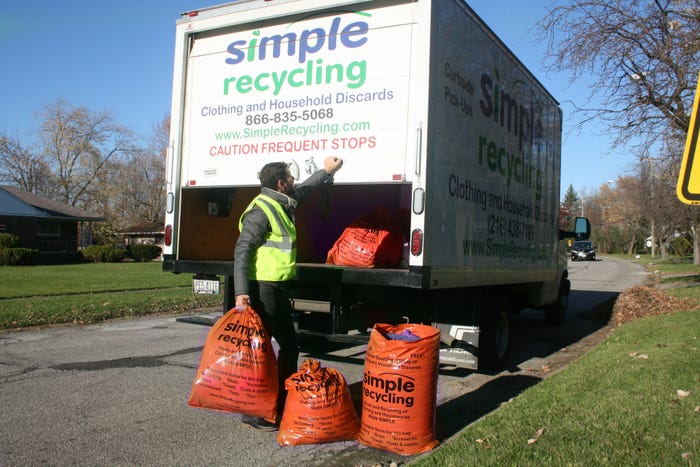Early Efforts to Tackle Mounting Textile Waste (Part Two)
Part two of a three-part series this week explains how innovators are working to pump lagging textiles recycling.

In a multipart series this week, Waste360 will examine the problem of textile waste and how some companies and municipalities are working to develop effective and efficient recycling and waste reduction efforts. To read part one, click here. To read part three, click here.
Twenty-seven billion pounds of textiles are landfilled in the U.S. every year, and at least 85 percent could be reused, say sustainability industry experts. So, brands, technology developers, municipalities and others are brainstorming ways to recover these materials and see that they serve a purpose. High-tech sorting technologies are starting to emerge, technologies to spin spent textiles back into fiber for new products are inching forward and unique collection models and partnerships are evolving.
At the core of these innovations is a focus on closing the loop to create a circular supply chain.
Software company Curb My Clutter developed a platform leveraging smartphone technology to increase efficiency in curbside clothing collections. Residents schedule appointments via text, take pictures to inform in advance of inventory and chose from collection times and receive reminders.
The company develops route lists and does pickups, but it has taken its role further during its current pilot stage, with a future strategy in mind.
“For now, we are doing it all to prove out the system—scheduling, collecting, sorting and delivering to buyers,” says Bob Anderson, vice president of business development for Curb My Clutter. “We even rip open the bags to know what’s inside. But the ultimate goal is to offer our platform to haulers, municipalities and brands [to leverage in their own recovery efforts].”
The software is designed to help brands understand what could be returned to them, to provide haulers a means for more efficient collections and to give buyers transparency.
It features a rewards component to provide brands with a motivational tool. In time, says Anderson, it may be built out so that if brands want specific items back, they could be pulled, though materials would have to be separated after collection.
Contracting with municipalities, Curb My Clutter now services 40,000 New Jersey households as of mid-May.
Global company I:CO has a takeback system to collect clothes and shoes at retail stores to be prepared for reuse or recycling. Textiles are sorted into up to 350 categories.
What can’t be reused in its original form may be recycled for wiping cloths, turned into insulation or spun back into fiber for other clothing.
Working with one of its 40-plus retail partners, I:CO established a process to recycle cotton to make new denim.
“To make new denim, the challenges are collecting enough of it and breaking it down into a fiber, which we have done,” says Jennifer Gilbert, chief marketing officer of I:CO. “We continue to push the envelope to increase the percentage of recycled fibers, working with brands and technology companies.”
On the manufacturing side, Eileen Fisher also has a takeback program and has received more than 8,000 pieces of clothes and generated $10 million in resell revenue since 2009.
“We have been evolving the brand to expand into reuse, not just resell. If we can’t resell, we would redesign or take it apart and put it back together,” says Cynthia Power, facilitating manager of Eileen Fisher’s Renew program.
Technology to make this reuse model scalable is lacking, though the brand is starting to work with mills and recyclers to expand and projects growth in this space.
Like I:CO, the Renewal Workshop partners with brands. It takes brands’ unsellable products to its Cascade Locks, Ore., facility, where what can be renewed is cleaned, repaired and resold online. Brand partners receive a revenue share or pay a renewal fee, and then sell the products through their own channels.
At pilot scale, unsalvageable garments are organized by material type and sent to recyclers who turn it into a new yarn. Ideally, the recycler will make money, and it will eventually be a savings for the apparel brand, says Nicole Bassett, co-founder of Renewal Workshop.
Simple Recycling offers free curbside collections on residents’ recycling day.

The company aggregates and sells materials in bulk, mainly to thrift store chains.
“We don’t sort,” says Adam Winfield, president of Solon, Ohio-based Simple Recycling. “The U.S. reuse and resale market prefers to determine what is resalable. We offer downstream partners expertise on international recycling markets for what they can’t sell through thrift stores.”
The company began pilots in two towns and now reaches 2 million households in 10 marketplaces.

The business model is driven by value of material, unlike the common model where revenue comes from collection and processing fees.
“One of our biggest challenges is maintaining community awareness about our program,” says Winfield. “This is a partnership with the city, and when they use their communication channels to inform residents, participation and diversion rates are high."
About the Author
You May Also Like




.png?width=300&auto=webp&quality=80&disable=upscale)